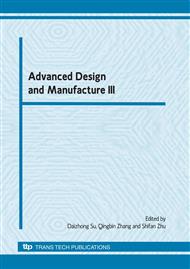p.506
p.510
p.514
p.518
p.522
p.526
p.530
p.534
p.539
Investigation on Finite Strain Constitutive Model with Logarithmic Strain Based on Torsion Experiments
Abstract:
In this paper, a finite strain constitutive model was proposed by the additive decomposition of the logarithmic strain rate and the generalization of small deformation constitutive model and a complete analysis was made for an isotropic hardening J2 flowing finite strain constitutive model based on torsion experiments. Logarithmic strain and Jaumann stress rate were discussed in solid circular shaft torsion deformation. Utilizing the results obtained from solid circular shaft torsion experiments, the plastic rigidity function in constitutive model was determined. The simple shear problem was studied by using the constitutive model given in this paper. The results shows that the plastic rigidity function corresponding to logarithmic strain was different from one to Green strain and finite strain constitutive model should be analyzed by logarithmic strain and torsion experiments.
Info:
Periodical:
Pages:
522-525
Citation:
Online since:
November 2010
Authors:
Price:
Сopyright:
© 2011 Trans Tech Publications Ltd. All Rights Reserved
Share:
Citation:


